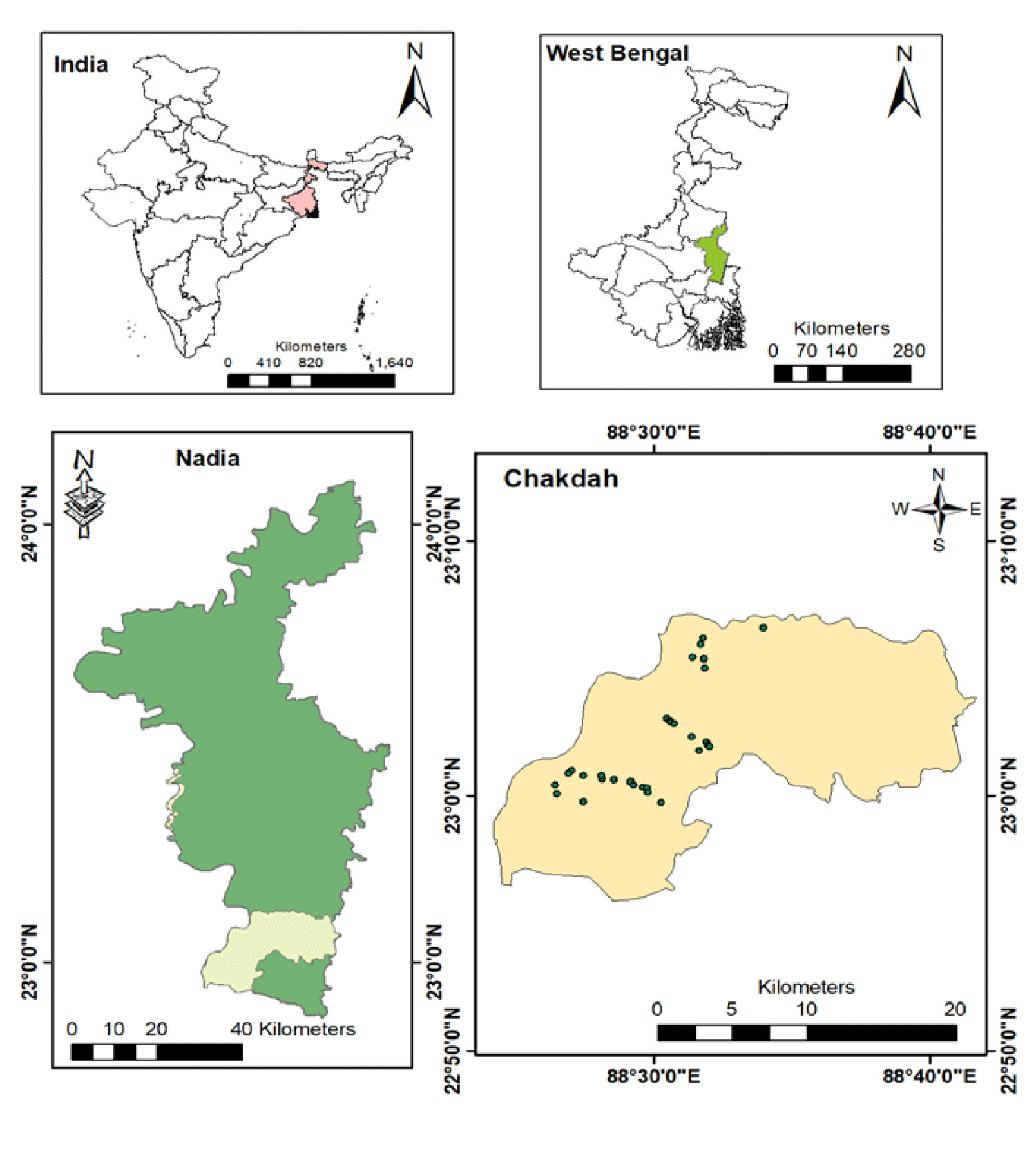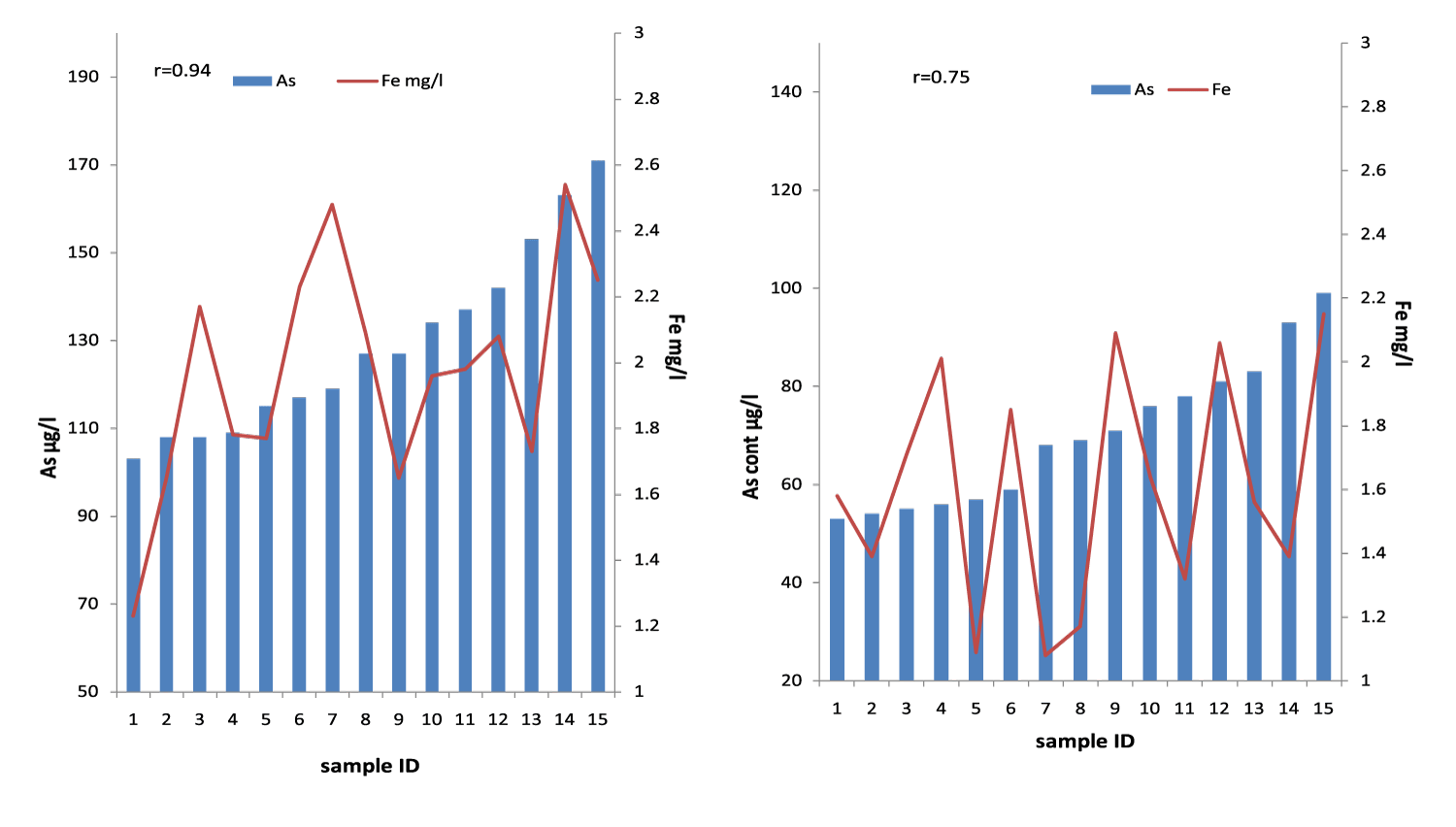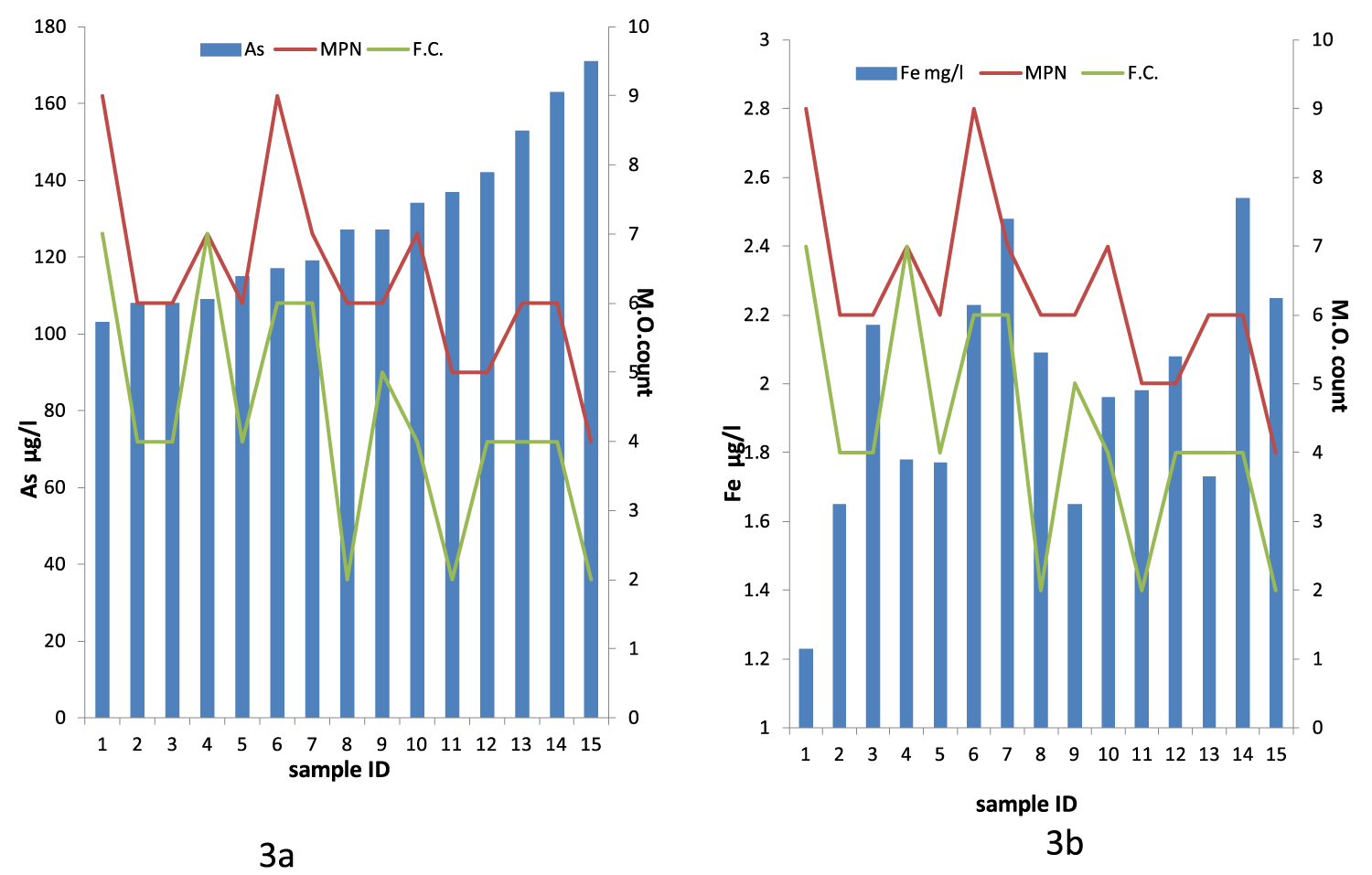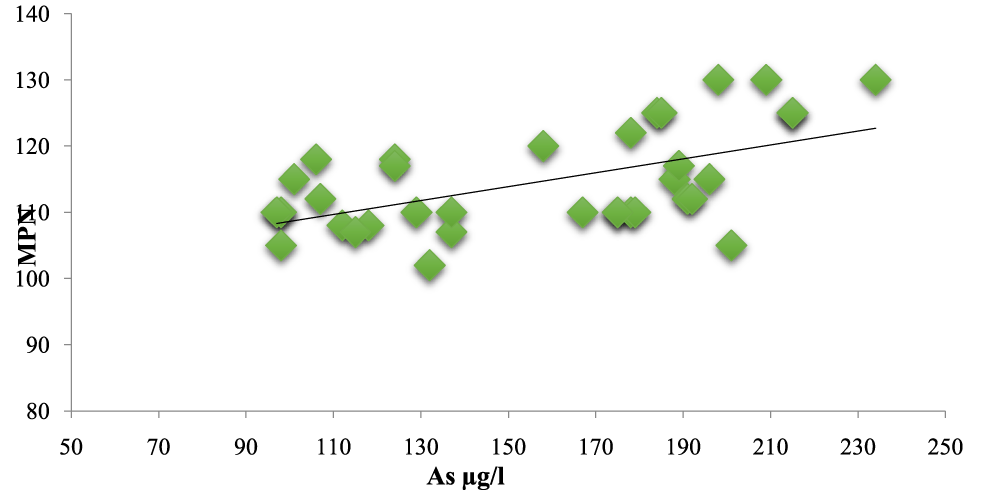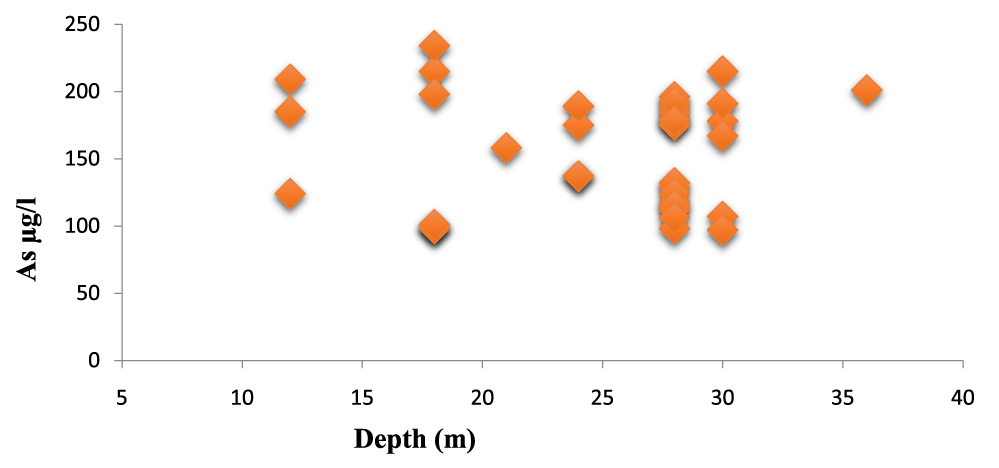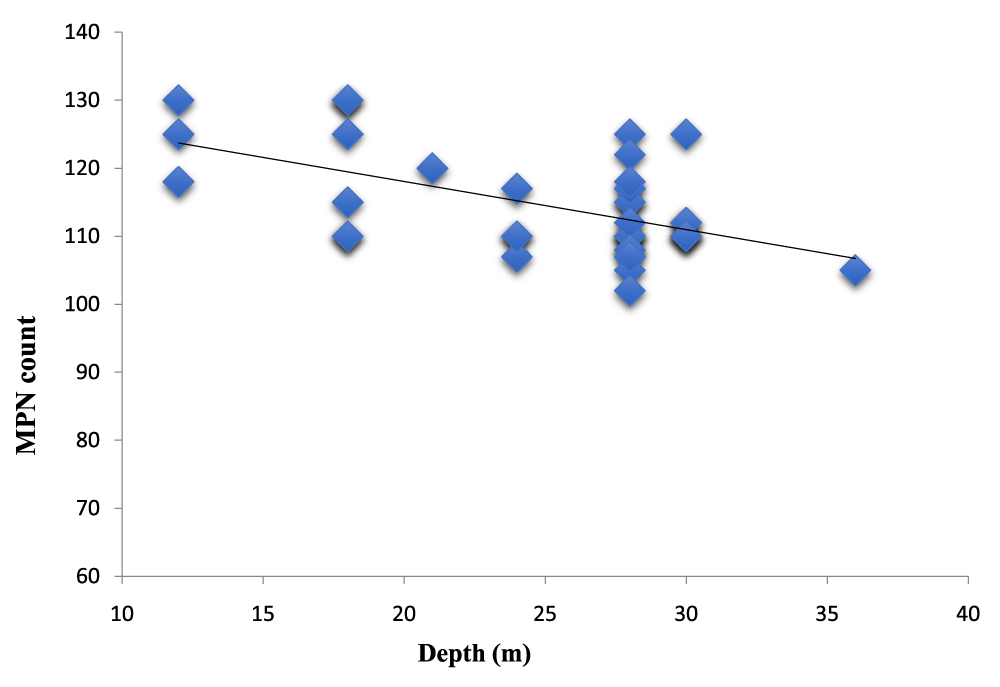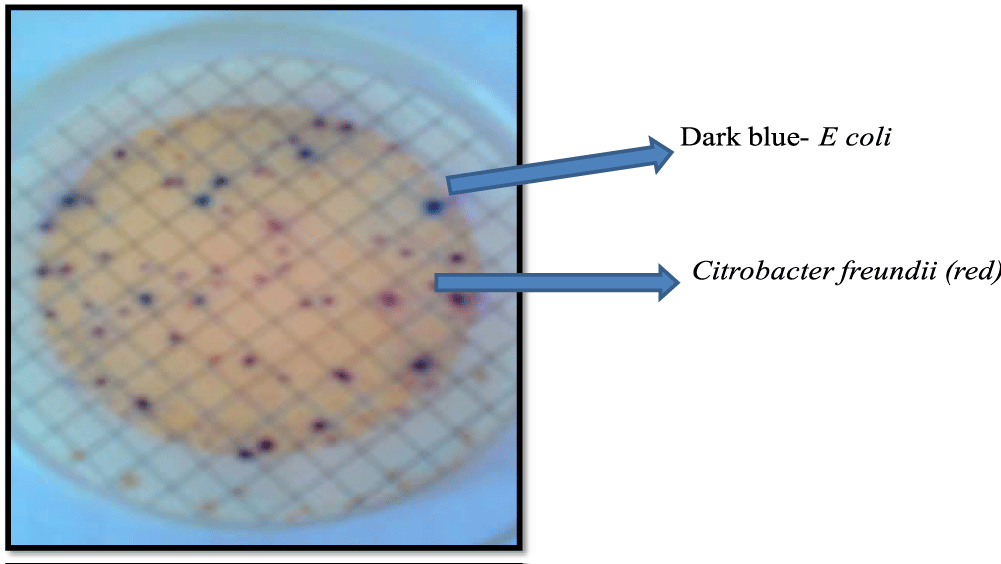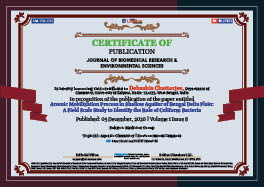> Medicine Group. 2020 Dec 05;1(8):372-382. doi: 10.37871/jbres1168.
Arsenic Mobilization Process in Shallow Aquifer of Bengal Delta Plain: A Field Scale Study to Identify the Role of Coliform Bacteria
Pinaki Ghosh1, Ayan Das1, Madhurina Majunder1, Samir Kumar Mukherjee2 and Debashis Chatterjee1*
2Department of Microbiology, University of Kalyani, Nadia-741235, West Bengal, India
- Arsenic
- Iron
- Microorganisms
- Fecal coli form
- Aquifer
- Sulfate
- Bicarbonate
- Nitrate
- DO
In Bengal Delta Plain (BDP), shallow aquifer (<50 m) is often contaminated with Arsenic (As). The phenomenon is wide spread in nature thought the BDP notable in Nadia district of west Bengal. The present study highlights a primary screening of As, Fe, MPN and FC in monitored shallow wells. The study designed for two different sites (site-A, High As and site-B Low As area). The water quality monitoring results suggest that high As concentration (Range- 103-171 μgL-1) has been noticed in site A when compared with site B (range-53-99 μgL-1). In sites A, the Fe concentration is high and low in site B. The correlation study (r2) between arsenic and iron are also determined. The value of r2 is 0.94 for site A and 0.73 for site B. The water quality results suggest that the nature of the monitor aquifer is anoxic in nature with low Eh, DO absent and low NO3- and SO4+. Major anion is HCO3- (376 mgL-1) followed by Cl- (28 mgL-1). However chloride concentration is largely varying in the monitored tube well. Microbial study (MPN & FC count) also indicates some relationship among MPN (r2-0.32) and Fe (r2 -0.24). However the relationship is scatter when As concentration is low. The linear trended has also obtained when both As, MPN and FC are high. The physical observation of plate count (Color reaction in Chromo colt Agar) has also been observed. This is a clear indicator of fecal coli form contamination. The study indicates that the microbial mobilization of As is the key factor for enrichment of As in ground water. The possible sources of the microbes are local land-use pattern (notable pit-latrine). Finally, the study highlights the role of coli forms bacteria (Both facultative and non-facultative) are wide spread in shallow rural aquifer of Bengal. Thus microbial process possibly enriches arsenic in shallow ground water.
Arsenic (As) is one of the most prevalent toxic metalloid in the environment. Most of the shallow aquifers (< 50 m) in the BDP, predominately Gangetic alluvium plains are now extensively contaminated with As. In BDP, people are starting to use ground water for their drinking, cooking also domestic purposes from early seventies (1971). However, As contamination from groundwater is widely spread throughout the BDP over the years and often found exceeders the WHO guide line value (>10 μgL-1) as well as National safe limit (>10 μgL-1) [1-3]. Large rural areas of west Bengal and adjoining part of Bangladesh have been identified with As and Fe concentration in shallow aquifers (AsT upto 1186 μgL-1, FeT upto10 mgL-1) [4]. It has already been reported that the primary ingestion route of As and microorganism are from drinking water [5]. Major regional rivers are Ganges, Brahmaputra and Meghna along with their various tributaries and distributaries jointly drain the entire BDP alluvium plains and forms world’s fourth largest riverine system and draining upto Bay of Bengal. The uncontrolled and unregulated disposal of municipal sewage (even raw / partially treated) in these rivers has made these natural fresh water sources unfit for human consumption [6]. As a result, millions of hand–operated tube wells are indiscriminately installed throughout the soft alluvium of BDP by the enterprise of local inhabitants as well as state /local governments’ initiative to supply the drinking water among the community. The motive of the initiative is to paradigm shift from surface water to groundwater to avoid the numerous water borne diseases caused by pathogens which are usually prevailing in this part of the globe. The social dependence of ground water has been largely increased because the resource is affordable, easy availability. Over the time, it has been advocated that the wide spread As distribution in BDP is geogenic in nature and releasing As under anaerobic condition [7,8].The process is controlled by bacteria when they are gaining energy through degradation of organic matter where metal reducing bacteria plays an important role to release As in groundwater by reducing Fe –oxides/oxyhydroxides phases [9,10]. Presently, microbially mediated oxidation of organic matter coupled with Fe-reduction is the most widely accepted As release mechanism that has been reported to explain the high As levels in BDP shallow (< 50m) aquifers. However, the source of organic matter in the shallow BDP aquifers and the role of bacteria are quite notorious and even contradictory [11,12]. Nevertheless, the recent studies suggest that the scope of microbial contamination in groundwater. The study indicates that several type of land use pattern (sanitary installations, local ponds, cattle settlements, agricultural field) are existing in rural part of the BDP Nadia, West Bengal. In this context, the present study deals with the examination of possible microbial contamination in drinking water wells where the tube well water is considered as an assumed safe drinking water source. Moreover, the study also focuses the relationship of As and Fe with microbial contamination in groundwater. Finally, a field based exploration has been further documented to deal with the paucity of information in relation to the role of microorganism in As affected areas of the central BDP (Nadia, West Bengal) to bridge- up the knowledge gap.
The study area is located at Chakdaha Block (23.02-23.14°N, 88.49-88.62°E), Nadia District, West Bengal 65 km north of Kolkata Megacity and nearly 190 km inland from the present coastline of Bay of Bengal figure 1. There is a gentle hydraulic gradient of the groundwater flow pattern which is sloping towards the South East to South. The area is adorned with several geomorphological appearances within the active flood plain of Hooghly – Bhagirathi and is differentiated by a series of oxbow lakes, meander belts and scars, abandoned channels and rudiments of minor rivers of varied wave-lengths and amplitudes.
The primarily of drinking water by the entire rural population of the surveyed villages (Chanduria-II, Madanpur-I, Madanpur-II, Routari, Sorati & Tatla). Nearly each household of the surveyed villages is using tubewells (private wells) for their domestic purposes (drinking, cooking and bathing). These tube-wells are hand operated and generally shallow (<30m) in depth depending on availability and the sustainable level of groundwater. In many cases, the location of the tube-wells (site selection) are under stress (unfavorable) environmental conditions such as the distance of the tube-well from pit –latrines, ponds often contaminated with leakage sewage, surface run off and agricultural returns and cattle settling and their waste dumping areas. This adverse land-use pattern is often contaminated with human–pathogenic bacteria. Islam, et al. [13] has already reported from Matlab, Bangladesh that all the collected tube-well water samples contained bacteria and pathogens originated from human waste. These tube-wells are also extensively used for drinking purposes and often exceeding the As levels above the WHO guideline value (10 μgL-1). During field survey, it has also been observed that large numbers of irrigation wells are also located in those villages where drinking water wells are shallow (< 50 m) and under pumping effect. It seems that excessive groundwater pumping facilities contaminant migration from sediment-water interaction along with cross contamination with high As areas and also contributes to regulate groundwater geochemistry [14,15].
Geographical coordinated of the tube well was record by hand-held Global Positioning System (GPS, Garmin Etrex, and Made in Taiwan). In the field each tube well sanitation survey was examined carefully and recorded .Tube well depth and installation year were also recorded from tube- well owners. During well head sampling, each tube well was purged for a half an hours prior to collection of ground water sample to get the fresh groundwater samples from aquifers. Certain parameters (pH, Eh, conductivity, temperature and DO) were measured on-site continuously by using a flow cell and Field Multimeter (WTW, field multimeter, Germany). After stabilization of these parameters in field condition, the final values were recorded and the groundwater was sampled. The alkalinity was measured on –site using a field kit (Merck, 1.11109.001 Alkalinity Test Kit). The samples for the major cations, trace elements and anions were filtered on-site using 0.45 µm membrane filter (Axiva) whereas samples for major cations and trace elements were acidified with HNO3 (1% v/v, Suprapure, Merck). The samples for major anions were left un-acidified. Microbial analyses (Total and fecal coliform count) of the water samples were also determined. ISO 9308-1:2014 specifies a method for the enumeration of Escherichia Coli (E. coli) and coliform bacteria. The method is based on membrane filtration, subsequent culture on a chromogenic coliform agar medium, and calculation of the number of target organisms in the sample. Chromocult Coliform Agar is a selective and differential chromogenic culture medium for the microbiological study of water samples. Surrounded by 24 hours this medium enables the real-time exposure, separation and details of E. coli and coliform bacteria in drinking water. Counting of coliform bacteria is based on the abilityof s-D-galactosidase, an enzyme which is characteristic of coliform bacteria, to cleave the substrate Salmon-GAL as a results salmon gal show red colored coliform bacteria colonies figure 8. Counting of E. coli is based on the cleavage of both the substrates X-glucuronide by s-D-glucoronidase and Salmon-GAL by s-D-galactosidase, an enzyme combination, which is characteristic of E. coli. In the presence of E. coli both substrates are cleaved, resulting in colonies that take on a dark blue to violet color as opposed to the salmon red of other coliform bacteria colonies. Non-coliform bacteria appear as colorless or in rare cases as turquoise colonies. The CCA formulation contains sodium heptadecylsulfate (e.g. TergitolR 7) as an inhibitor of Gram-positive bacteria with no negative effect on the growth of the targeted coliform bacteria / E. coli [16,17]. NH4+ and anions were analyzed overnight after field sampling to minimize the redox alteration by using Ion Chromatography (761 Compact IC, Metrohm). For FeT measurement, all the Fe is converted into the ferrous state by boiling with hydrochloric acid and hydroxylamine. The reduced Fe chalets with 1, 10-pheninthroline at pH 3.2 to 3.3 to form a complex of orange-red colour. The intensity of this color is proportional to the concentration of Fe and was determined spectrophotometrically by comparing against standards. The intensity was measured using a UV-VIS spectrophotometer (Lamda 20, Perkin- Elmer). The major cations and trace elements were measured by inductively coupled Plasma Optical Emission Spectrometer (ICP-OES, Varian, and Vista-PRO). For the entire element, the precision of analysis was > 97%. In addition, the concentration of AsT have been analysis by hydride generation atomic absorption spectrophotometer (HG – AAS, Varian-240, which detection limit <1 μg/l). Generally aqueous redox parameter was classified into two groups. One of parameter such as As & Fe was high solubility and lower oxidation states (III, II & II, respectively) also microbial population counts (TC & FC). The correlation matrixes for every tube well depth were calculated based on aqueous concentration of this redox parameter during the dry season (gradually 2 years), using the statistical software package SPSS (IBM, version, 17) was used for all statistical analysis. Pearson correlation coefficient (r) between different analyzed parameters was determined by standard methods.
where X and Y are two set of variables. As per convention more the calculated value of correlation closer to ± 1, more significant correlation between those variables is established.
Primary screening of water quality
Specific hydro chemical character (As and Fe), along with microbial quality of ground water (MPN count) count are determined in the monitored wells. It is a screening test to study the relationship in between As along with Fe and microbiological quality of water. Initially, two different sites (Site-A, high Arsenic and site-B low arsenic) have been identified in this study area. The hydro chemical analysis data figure 2 is presented to investigate a compression between site – A and site-B. In general, the site-A indicates relatively high As concentration (range-103-171 µgL-1; 1a, figure 2) when compare with site-B (mean -53 μgL-1 ; median-69 µgL-1 ; range-53-99 μgL-1; 2a, figure 2) In site –A, the As concentration in the monitored wells range between 103 to 171 μgL-1 with the majority above 137 μgL-1. On the other hand, the site –B the As concentration lies in between 53 to 99 μgL-1 with the majority above 69 μgL-1 . The similar situation has also been observed in case of Fe. In site –A, the Fe concentration range between 1.23 to 2.54 mgL-1 where as in site –B the Fe concentration values in-between 1.08 to 2.15 mgL-1. The statistical correlation in between As and iron has also been determined found that r2 value is 0.94 for site –A whereas for site-B r2 value is 0.73. The study indicates that Fe oxides/hydroxides are the principal host materials to release As in ground water [18,19].
The bacteriological characteristic of ground water (MPN and FC count) along with As & Fe concentration from Site – A and B are presented in graphical form figure 3. It has been found that all most all the wells are microbiological contamination in Site-A with regards to MPN counts figure 3.The montoring wells exhibited in a mixed proportion of microbial contamination which indicates the presences of natural sources. These sources do not usually occur in elevated concentration because their often dispersed in nature and mixed in verity, such as sanitation, pond water, and cattle waste dumping [20,21].
Microbiological contamination is often dispersed, sporadic and usually influence by large number of interacting local environmental factor, such as physical characteristic of the monitored wells, climatic condition. Land –use pattern, demography and distribution pattern of habitation and agricultural practices [22,23]. Since the monitored water wells have both fecal coliform and MPN count, more over their regular presences in the well water sample is a strong evidence of local microbial contamination. However the As concentration is also largely varying. The variation in As concentration is due to microbial mobilization of As from sediment to ground water where local anthropogenic sources are playing key role [24,25]. During field visit, it has been found that this monitored well are constracted near the sanitary installation where the Fe concentration is varying from 1.08 to 2.15 mgL-1 whereas MPN counts vary from 6 to 9 and FC is varying 4 to 7 counts. The Fe concentration is relatively low in comparison to the other reported works in the study area. For example Biswas, et al. [8] reported that As and Fe concentration in the monitored well are upto 562 μgL-1 and 5.26 mgL-1, whereas Bhowmick S, et al. [7] reported that As and Fe concentration are 399 μgL-1 and 3.65 mgL-1. All the previous studies suggested that Fe and As are relatively high in the monitored ground water samples. However those studies do not mentions any microbial quality of drinking water as well as their association with local environment, particularly sanitation installations.
A further study has also be conducted where the As along with MPN and FC count was measured in relatively shallow wells (<20m). The results have been presented in figure 4. It has been found that the As concentration is relatively increasing upto 171µgL-1 in the monitored wells where as MPN and Fe concentration are fluctuating in nature in those wells. The As concentration has been increasing in those water wells where sanitation installations are within 2 to 3 m. Additionally, MPN and Fe counts peaks are also found in those wells. However in some of the wells As concentration have been relatively high upto 171 μgL-1where as Fe and MPN count have been lower with regards to As concentration. Such lowering of FC and MPN values may be linked with the distances of sanitary installation with the monitoring well (> 2-3 m), however the prevalence of microbial community and their die off period depending on several factor and most importantly the distance between wells and latrine.
The analysis of the bacteriological characteristics of ground water (FC & MPN count) along with ground water Fe concentration is also monitored figure 4. The results revel that there is large fluctuation both in MPN and FC count along with variation of Fe concentration in the collected sampled. Several high count values of both MPN & FC have been observed along with their low count values. The Fe concentrations are also varying with regards to both MPN & FC count. However, the MPN & Fe high concentration as well as low concentration peaks are showing nearly similar pattern. On the other hand, variation pattern of Fe concentration has shown discrepancy with MPN & FC count both in high and low peak values. The study indicates that the possible source of microbial contaminations is common for both MPN & FC counts. Which is dispersed in nature [26,27] during transport and retention behabheair of microorganism (aquifer physical condition) can be seriously affected by local environmental conditions. Moreover the aquifer chemical nature is changing with regards to the distance between wells and microbiological sources (e.g. sanitation installation). Specific organism concentrations may not be successfully monitored because there are either clumped organism and/or may be associated with solid particles (mostly colloidal) which are in different pattern of charges. Iron concentrations are varying due to reduction of Fe host under local anaerobic condition of the monitored aquifer. The anaerobic condition of aquifer depends on several factors such as aquifer geometry, Fe concentration of sediment, nature and type of organic matter, presences / absences of other oxy-anaion [28,29].
Ground water quality and arsenic mobilization
A survey of the water quality data of the monitored drinking wells (usually shallow, < 50 m) in the study area reveals that typical anoxic nature of the aquifer with the low Eh [mean (-) 276] and low to very low (Even absent, BDL) of DO regardless of land-use pattern and terrain character table 1. The most important feature is the monitored shallow aquifer of the Gangetic alluvial (young deposits) is often found to be practically devoid of DO associated with low to very low Eh. This has also been reported by the earlier workers. The pH of the ground water is circumferring neutral (min 6.68, max 7.12) which indicates that it has high buffering capacity. The highest temperature of the ground water is upto 31.7°C, whereas the mean is 27.08°C. This means that the ground water is typically in tropical environment [30,31]. The conductivity of the water has been also recorded (mean 598 mgL-1, max 834 mgL-1, min 398 mgL-1). Such moderate conductivity indicates the freshness of ground water. The TDS (total dissolved solids) has also been recorded where the mean value is 388 mgL-1. This suggests that there are several dissolved cations and anions in the system due to intensive sediment-water interaction. The chemical characteristics of the ground water are also studied table 1. It has been found that the major anion is bicarbonate (mean 376 mgL-1) which is followed by chloride (mean 28 mgL-1), sulphate (mean 9.46 mgL-1), ammonia (mean 3.40 mgL-1) and phosphate (mean 2.51 mgL-1). Among the anions chloride concentration is largely varied upto 159 mgL-1with a low mean value 28 mgL-1. Chloride is a conservative ion and such large variation of chloride is an important issue in the BDP shallow aquifer. During the field study the high concentration of chloride wells are usually owned by private owners (Household wells)
Table 1: Summary of the Concentration Ranges of Groundwater Constituents Sampled in Study area. |
|||
| Parameters | Max | Min | Mean |
| Depth (m) | 50 | - | - |
| Temperature (0C) | 31.7 | 19.6 | 27.08 |
| Conductivity (µ Scm-1) | 834 | 372 | 598 |
| pH | 7.12 | 6.68 | 6.89 |
| DO (mgL-1) | 0.10 | BDL | BDL |
| Ca+2 (mgL-1) | 347 | 179 | 295.6 |
| Mg+2 (mgL-1) | 208 | 115 | 161.5 |
| TDS (mgL-1) | 539 | 237 | 388 |
| HCO-3 (mgL-1) | 576 | 243 | 376 |
| Eh (mV) | 487 | -175 | -276 |
| Cl- | 159 | 1.84 | 28 |
| NH4+ | 4.58 | 1.49 | 3.40 |
| PO43- | 3.78 | 1.31 | 2.51 |
| SO42- | 17.8 | 2.74 | 9.46 |
| Na+ (mgL-1) | 31.78 | 14.60 | 26.5 |
| DOC (mgl-1) | 3.19 | 1.01 | 2.92 |
| AsT (µgL-1) | 315 | 129 | 278.5 |
| FeT (mgL-1) | 3.51 | 1.37 | 2.20 |
| TC (CFU/100mL-1) / MPN | 125 | 107 | 117.5 |
| FC (CFU/100 mL-1) | 72 | 12 | 28 |
| K+ (mgL-1) | 12.39 | 9.68 | 11.09 |
Whereas the low chloride concentration wells are generally owned by local Government and usually used by the community. Earlier studies already demonstrated that land use pattern (sanitation installations, pit – latrines, surface water bodies, cattle settling and agriculture land run off) has some local influence in increasing both As and Fe in ground water. It has also been reported that among these factors sanitation (pit-latrine) could be the most important factor towards enhancing the redox process where fresh organic matter is playing an important role. The other anions (HCO3-,PO43-, SO42- and NH4+) are relatively less variable when compared with the variability of chloride. The mean value of bicarbonate is relatively high (376 mgL-1) in comparison to the mean values of the other anions (PO43- 2.51 mgL-1, SO42- 9.46 mgL-1, Cl- 28 mgL-1). The mean value of bicarbonate is also a common feature of BDP shallow aquifer along with low Eh values [32,33]. This clearly suggests that the source of bicarbonate is also an important issue regarding their high concentration in ground water. The carbonate mineral dissolution (Calcite and dolomite) is the principle source of bicarbonate in the ground water. Nevertheless, the breakdown of organic matter is another important issue which can also contribute towards bicarbonate concentration in ground water. The chemistry of such processes is important and can largely contribute to high As levels in shallow (< 50 m) aquifer of BDP. In this context, the breakdown of organic matter under the local reducing conditions is important and often helps to augment such breakdown in natural environment the nature, characteristics, amount and type of organic matter are also playing an important role during their breakdown in natural environment. Role of ammonia and phosphate are also important. The present of ammonium ion is also another important issue with regard to the reducing environment of the aquifer. The formation of ammonium ion is further indication of prevailing reducing environment where organic form of nitrogen has been converted to ammonium ion under local reducing condition. The presence of phosphate in shallow aquifer in BDP is already reported by several workers .The source of phosphate will be both anthropogenic and natural. In BDP, by and large the common phosphate bearing minerals are usually absent such as apatite, vivionite, whereas the phosphate from fertilizer source has already been reported and evident by the various workers [34,35].
Microbial population and cation-anaion analysis
The TC (Total Colifirm) has also been dertermined in sampled groundwater collected from private wells which are regularly used for drinking purposes. It has been found that TC ranged from 125 to 107 (mean 117.5) cfu per 100 mL-1.This indicates that groundwater samples are failed with regard to microbiological quality when compared with both National Standard (IS 10500:2012) and WHO guideline value. Similarly, the Fc (Faecal coliform) has also been examined in the sampled groundwater. The bacteriological water quality in terms of FC has been found in between 12-72 cfu per 100 mL-1 with a mean value of 28 cfu per 100 mL-1 in the monitored drinking water wells. The results indicate that bacteriological quality of the sampled groundwater is often questionable with regard to WHO guideline value and Nation drinking water standard (IS 10500:2012). This is a serious issue with regard to public health because local inhibitants generally believed that groundwater is relatively free of bacteriological contamination therefore the raw fresh water is fit for human consumtion without any treatment even without addition of any disinfactants. Ammonia-N was also noticed to be high in many samples (Upto 86%) with a minimum concentration of 1.49 and maximum concentration of 4.58 mgL-1 where bacteriological contamination has been found. Moreover, PO43- concentration was also found to be high (upto 3.78 mgL-1) when compared with world standards (< 0.1 -1.9 mgL-1) in shallow aquifers (< 50 m). These findings (Distribution pattern and co-occurrence) further support the good possibility of bacteriological contamination in the monitored wells where N and P can act as nutrient source for such microbial activities and their associated energy-driven processes. It has also been recorded that Do (Dissolved Oxygen) has been depleted in most of the monitored samples (even absent) along with low Eh values which turns the system typically reducing nature accompanied by a continuously declining redox potential. As a result, a dynamic competition between different heterotrophic microbes (Mostly pathogens) has to be occurred and the metabolic pathways they are able to use for decomposition of organic matter (Mostly dissolved) and the break down dissolved species are more liable to gain the highest energy yield from available organic matter to allow growth pattern [36,37].
Among the cations Ca2+ is the highest (Upto 347 mgL-1) followed by Mg2+ (Upto 208 mgL-1), Na+ (31.78 mgL-1), K + (Upto 12.39 mgL-1), FeT (Upto 3.51 mgL-1) and AsT (315 µgL-1). The dissolution of sedimentary carbonate is a typical example of intensive interaction of sediment-water. A very large range (129-315 μgL-1) of As concentrations has been found in the monitored wells. The minimum concentration is 129 µgL-1 and the maximum has been found 315 μgL-1. It has been stated that most of the tube wells (~ 90%) are exceeding WHO guideline values (< 10μgL-) as well as National standard (< 10µgL-) (WHO 2010, BIS 10500, 2012). Perhaps the most important distinction in As concentrations is depth dependence which has been clearly noted in several parts of BDP. Similarly, the concentrations of dissolved FeT high (upto 3.51 mgL-1). Iron is released by reductive dissolution of Fe-oxides / Oxyhydroxides and weathering of natural mica (notably biotite). The Fe–reduction process favors As release in the groundwater which strongly reflects that the mobilization process is redox driven control behavior of the aquifer. Moreover, the DOC values of the sampled groundwater is relatively high (upto 3.19 mgL-1, mean 2.92 mgL-1) which also supports that the aquifer is under reducing condition. The local recharge through various land- use pattern do have some role to contribute towards the concentrations of DOC in the shallow aquifers. The study further accomplished that the drawdown of surface driven fresh organic matter notably through pond /ditch and pit-latrine are occurring because of large-scale groundwater extraction is the origin of this young DOC in shallow aquifers of the study area. The ground water As concentration of the individual tube well along with their MPN count have been investigated figure 5. The results indicate that As and MPN count have some relationship (R2 = 0.53) in the monitored wells. It has also found that the nature of the curve is scattered with regards to relatively low As concentrations (> 150 μgL-1). Nevertheless, rest of the plotting figure 5 shows some upward tendency (increasing AsT concentration with increasing MPN count) and also the nature of the curve shows linearity in pattern. This is an important finding with regards to As concentration and MPN count in the monitored well. The relationship also indicates the likely hood of microbial contamination of ground water with regards to land-use pattern [38-40]. These land – use pattern may contribute local recharge to the shallow aquifer and there by their impact on the tube-well water quality including levels of dissolved As and Fe in groundwater.
The systematically examination of As levels along with fecal contamination in shallow aquifers is a serious public health issue because this may increasing health risk among the local inhabitances using those tube-well for prolong time as a source of drinking and cooking water. The study area is densely populated (Total population - 5,168,488, population density – 1569 km2) (Census 2011) with poor sanitation and hydraulic connectivity with shallow aquifer. The variation of piezometric head is high which reflecting that local recharge is possible from surface water bodies (Notably in March to June) to nearby shallow well. This indicates the entry of fresh organic matter in the aquifer resulting increase in microbiologically mediated redox reactions which ultimately increases As levels in groundwater [41,42].
The ground water As concentration and the tube-well depth have also been examined figure 6. It has been found that the range of high As concentration (100-250 μgL-1) is highly depth dependent. The study further reveals that 72.22 % of the tube well is within the depth range of 20 to 32 m, where As contain is varying from (52 to 230 μgL-1). This tube wells are yielding water 50 to 70 m3Hr-1 and several house hold used those tube-well regularly for their drinking and domestic purposes.
The MPN count distribution pattern with depth has been plotted figure 7. The 95% of tube-well are within the very shallow depth range (12-36 m) where MPN count varies (107 to 125 counts). On the other hand, MPN count has been relatively reduced in the deeper depth (27-33 m). In this depth zone, the MPN count is also varying (102 - 125 count) where 58% of monitored tube well are located. The study reveals that the MPN count is relatively high in the shallow part of the aquifer, which is often under the beneath of vardose zone. The wells in relatively deeper aquifer (27-35m) are relatively less contaminated in MPN count.
The study indicates that monitored tube-wells are often contaminated with MPN counts which are located in the shallower part of the aquifer where connectivity with local land- use pattern can be possible depending on nature of the aquifer. Neumann, et al. [32] recommended that the local recharges from pond carries degradable organic carbon into the shallow aquifer where dissolved As contain are greatest. The study further revels that land-use pattern are often influencing aquifer biogeochemistry and their pattern of As variation in the shallow aquifer also the results of variation of the such land-use pattern [43,44]. The study suggests that anthropogenic activity (Domestic waste and leakage sewage) may directly contribute to increase As concentration in the shallow tube-wells. The field investigation further suggests that such activities can contribute to the inflow of labile organic carbon along with NO3- andPO43- to the upper aquifer and their by stimulate the activity of microbial community. As a result, the shallower part of the aquifer is leading towards more anoxic condition and their by increasing the iron reduction process (Reductive dissolution process of iron oxide/ oxy hydro oxide) and subsequently released As into the ground water.
The ground water quality has been monitored and pH has also been recorded which is circumferring neutral. The conductivity of the water is moderate. The recorded TDS indicates that there are several dissolved cations and anions in the system due to intensive sediment-water interaction. The study suggest that shallow aquifer is typical anoxic nature with the low Eh and low to very low (even absent) of DO and nature of the alluvial plain. The ion chemistry reveals that the major anion is bicarbonate followed by chloride, sulphate ammonia (Mean 3.40 mgL-1) and phosphate (Mean 2.51 mgL-1). Among the anions, chloride concentration is largely varied upto 159 mgL-1with a low mean value 28 mgL-1. Land use pattern (sanitation installation (pit – latrine, surface water bodies, cattle settling and agriculture land) can also influence increasing the levels of both As and Fe in ground water. Sanitation (pit-latrine) could be the most important factor and enhancing the redox process when fresh organic matter is supplied to the shallow aquifer (< 50 m). Rest of the anions (HCO3-, PO43-, SO42- and NH3) is relatively less variable when compared with the variability of chloride. The mean value of bicarbonate is typically high (576 mgL-1) in comparison to the mean values of the several anions (PO43- 2.51 mgL-1, SO42- 9.46 mgL-1, Cl- 28 mgL-1). The principle source of bicarbonate in the ground water is the carbonate mineral dissolution (Calcite and dolomite). Moreover, bicarbonate concentration in ground water can also be possible by the breakdown of natural organic matter. The biological quality of the sampled groundwater reveals that TC ranged from 125 to 107 cfu per 100 mL-1and samples are failed with regard to microbiological quality when compared with both National Standard and WHO guideline value. Similarly, the FC has also been examined in the sampled groundwater . The bacteriological water quality in terms of FC has been found in between 72 to 12 cfu per 100 ml (Mean value 28 cfu per 100 ml) in the monitored drinking water wells. The both results (TC and FC counts) indicate the bacteriological quality of the smapled groundwater is often questionable. During field survey, it has also been found that these tube-wells are located in environmentally unfavoured conditions. Later on, it has been observed that the most significant causes of bacteriological contamination were found to be proximity (~ 1-4 m) of various pit-latrines, pond, ditch, bil, agricularural field and various other local surface water bodies. In most of the cases, well depth was found to be a signifacnt factor which is usually shallow (< 30m). Even in some cases, the deeper aquifers (> 30 m) are detected with Coliform which indicates cross – contimation from upper aquifers during large scale of groundwater development (pumping). Among the cations Ca2+ is the highest followed by Mg2+ (Upto 208 mgL-1), Na+ (31.78 mgL-1), K+ (Upto 12.39 mgL-1), FeT (Upto 3.59 mgL-1) and AsT (315 μgL-1). The As concentrations (119-315 µgL-1) has been found largely varying in the monitored wells, a range of three orders of magnitude and most of the wells (~ 90%) was exceeding according to WHO guideline value (+10 μgL-1) as well as National standard (< 10 μgL-1). Perhaps the most important distinction in As concentrations is depth dependence which has been clearly noted in several parts of BDP. The predominance of local reducing conditions in the aquifers indicates the reductive dissolution of Fe-oxides / oxyhydroxides and weathering of natural mica (notably biotite). The Fe–reduction process favours the desorption of As in the groundwater. The DOC value of the sampled groundwater is relatively high which also supports that the aquifer is under reducing condition. The presence of high DOC indicates the presence of fresh dissolved organic carbon from local recharge. The study further reveals that a significant part of the total microbial populations are found to be coliforms as evident from their colour reaction in Chromocault’s Agar, which in turn is an indicator of fecal contamination.
- American Public Health Association (APHA). Standard Methods for the Analysis of Water and Wastewater, 17th ed. American Public Health Association, Washington, DC. 1998.
- Appelo CA, Van Der Weiden MJ, Tournassat C, Charlet L. Surface complexation of ferrous iron and carbonate on ferrihydrite and the mobilization of arsenic. Environ Sci Technol. 2002 Jul 15;36(14):3096-103. doi: 10.1021/es010130n. PMID: 12141489.
- Bhattacharya P, Chatterjee D, Jacks G. Occurrence of arsenic contaminated groundwater in alluvial aquifers from Delta Plains, Eastern India: Options for safe drinking water supply. International Journal of Water Resources Development. 1997 Mar;13(1):79-92. doi: 10.1080/07900629749944.
- Bhattacharya P, Jacks G, Ahmed KM, Routh J, Khan AA. Arsenic in groundwater of the Bengal delta plain aquifers in Bangladesh. Bull Environ Contam Toxicol. 2002 Oct;69(4):538-45. doi: 10.1007/s00128-002-0095-5. PMID: 12232725.
- Bhattacharyya R, Chatterjee D, Nath B, Jana J, Jacks G, Vahter M. High arsenic groundwater: Mobilization, metabolism and mitigation--an overview in the Bengal Delta Plain. Mol Cell Biochem. 2003 Nov;253(1-2):347-55. doi: 10.1023/a:1026001024578. PMID: 14619986.
- Bhattacharyya R, Jana J, Nath B, Sahu SJ, Chatterjee D, JacksG. Groundwater arsenic mobilization in the Bengal Delta Plain, the use of ferralite as a possible remedial measure-a case study. Applied Geochemistry. 2003 Sep; 18(9),1435-1451. doi: 10.1016/S0883-2927(03)00061-1.
- Bhowmick S, Nath B, Halder D, Biswas A, Majumder S, Mondal P, Chakraborty S, Nriagu J, Bhattacharya P, Iglesias M, Roman-Ross G, Guha Mazumder D, Bundschuh J, Chatterjee D. Arsenic mobilization in the aquifers of three physiographic settings of West Bengal, India: understanding geogenic and anthropogenic influences. J Hazard Mater. 2013 Nov 15;262:915-23. doi: 10.1016/j.jhazmat.2012.07.014. Epub 2012 Jul 11. PMID: 22999019.
- Biswas A, Gustafsson JP, Neidhardt H, Halder D, Kundu AK, Chatterjee D, Berner Z, Bhattacharya P. Role of competing ions in the mobilization of arsenic in groundwater of Bengal Basin: insight from surface complexation modeling. Water Res. 2014 May 15;55:30-9. doi: 10.1016/j.watres.2014.02.002. Epub 2014 Feb 11. PMID: 24583841.
- Biswas A, Nath B, Bhattacharya P, Halder D, Kundu AK, Mandal U, Mukherjee A, Chatterjee D, Mörth CM, Jacks G. Hydrogeochemical contrast between brown and grey sand aquifers in shallow depth of Bengal Basin: consequences for sustainable drinking water supply. Sci Total Environ. 2012 Aug 1;431:402-12. doi: 10.1016/j.scitotenv.2012.05.031. Epub 2012 Jun 16. PMID: 22706147.
- Biswas A. Arsenic geochemistry in the alluvial aquifers of West Bengal, India: implications for targeting safe aquifers for sustainable drinking water supply (Doctoral dissertation, KTH Royal Institute of Technology). 2013.
- Biswas A, Majumder S, Neidhardt H, Halder D, Bhowmick S, Mukherjee GA, Kundu A, Saha D, Berner Z, Chatterjee D. Groundwater chemistry and redox processes: depth dependent arsenic release mechanism. Applied Geochemistry. 2011 Apr; 26(4),516-525.
- Borch T, Kretzschmar R, Kappler A, Cappellen PV, Ginder-Vogel M, Voegelin A, Campbell K. Biogeochemical redox processes and their impact on contaminant dynamics. Environ Sci Technol. 2010 Jan 1;44(1):15-23. doi: 10.1021/es9026248. PMID: 20000681.
- Islam FS, Gault AG, Boothman C, Polya DA, Charnock JM, Chatterjee D, Lloyd JR. Role of metal-reducing bacteria in arsenic release from Bengal delta sediments. Nature. 2004 Jul 1;430(6995):68-71. doi: 10.1038/nature02638. PMID: 15229598.
- Charlet L, Chakraborty S, Appelo CAJ, Roman RG, Nath, B, Ansari AA, Lanson M, Chatterjee D, Basu Mallik S. Chemodynamics of an As “hotspot” in a West Bengal aquifer: A field and reactive transport modeling study. Applied Geochemistry. 2007 Jul;22(7),1273-1292.
- Huq ME, Su C, Fahad S, Li J, Sarven MS, Liu R. Distribution and hydrogeochemical behavior of arsenic enriched groundwater in the sedimentary aquifer comparison between Datong Basin (China) and Kushtia District (Bangladesh). Environ Sci Pollut Res Int. 2018 Jun;25(16):15830-15843. doi: 10.1007/s11356-018-1756-1. Epub 2018 Mar 26. PMID: 29582329.
- Christensen TH, BjergPL, Banwart SA, Jakobsen R, Heron G, Albrechtsen HJ. Characterization of redox conditions in groundwater contaminant plumes. J Contam Hydrol. 2000 Oct;45(3):165-241. https://bit.ly/2JR5QEo
- Duxbury T, Bicknell B. Metal-tolerant bacterial populations from natural and metal-polluted soils. Soil Biol Biochem. 1983; 15, 243-250. https://bit.ly/3ov4EG1
- Fendorf S, Michael HA, van Geen A. Spatial and temporal variations of groundwater arsenic in South and Southeast Asia. Science. 2010 May 28;328(5982):1123-7. doi: 10.1126/science.1172974. PMID: 20508123.
- Finney M, Smullen J, Foster HA, Brokx S, Storey DM. Evaluation of Chromocult coliform agar for the detection and enumeration of Enterobacteriaceae from faecal samples from healthy subjects. J Microbiol Methods. 2003 Sep;54(3):353-8. doi: 10.1016/s0167-7012(03)00068-x. PMID: 12842481.
- Harvey CF, Swartz CH, Badruzzaman AB, Keon-Blute N, Yu W, Ali MA, Jay J, Beckie R, Niedan V, Brabander D, Oates PM, Ashfaque KN, Islam S, Hemond HF, Ahmed MF. Arsenic mobility and groundwater extraction in Bangladesh. Science. 2002 Nov 22;298(5598):1602-6. doi: 10.1126/science.1076978. PMID: 12446905.
- Harvey CF, Swartz CH, Badruzzaman ABM, Keon-blute N, Winston YU, Ali MA, JAY J, Beckie R, Niedan V, Brabander D, Oates P, Ashfaque KN, Islam S, Hemond HF, Ahmed MF. Groundwater arsenic contamination on the Ganges Delta: Bbiogeochemistry, hydrology, human perturbations, and human suffering on a large scale. C.R. Geosci. 2005 Feb, 337(2), 285-296.
- Lawson M, Polya DA, Boyce AJ, Bryant C, Mondal D, Shantz A, Ballentine CJ. Pond-derived organic carbon driving changes in arsenic hazard found in Asian groundwaters. Environ Sci Technol. 2013 Jul 2;47(13):7085-94. doi: 10.1021/es400114q. Epub 2013 Jun 20. PMID: 23755892.
- Leber J, Rahman MM, Ahmed KM, Mailloux B, van Geen A. Contrasting influence of geology on E. coli and arsenic in aquifers of Bangladesh. Ground Water. 2011 Jan-Feb;49(1):111-23. doi: 10.1111/j.1745-6584.2010.00689.x. PMID: 20236332.
- Mailloux BJ, Trembath-Reichert E, Cheung J, Watson M, Stute M, Freyer GA, Ferguson AS, Ahmed KM, Alam MJ, Buchholz BA, Thomas J, Layton AC, Zheng Y, Bostick BC, van Geen A. Advection of surface-derived organic carbon fuels microbial reduction in Bangladesh groundwater. Proc Natl Acad Sci USA. 2013 Apr 2;110(14):5331-5. doi: 10.1073/pnas.1213141110. Epub 2013 Mar 4. PMID: 23487743; PMCID: PMC3619377.
- Majumder S, Datta S, Nath B, Neidhardt H, Sarkar S, Roman RG, Berner Z, Hidalgo M, Chatterjee D. Monsoonal influence on variation of hydrochemistry and isotopic signatures: Implications for associated arsenic release in groundwater Journal of Hydrology. 2016; 407-417. https://bit.ly/39LkzMm
- MC Arthur JM, Ravenscroft P, Banerjee DM, Milsom J, Hudson-Edwards KA, Sengupta S, Bristow C, Sarkar A, Tonkin S, Purohit R. How paleosols influence groundwater flow and arsenic pollution: A model from the Bengal Basin and its worldwide implication. Water Resour Res. 2008; 44: 1-30. https://bit.ly/3oprRcv
- Michael HA, Voss CI. Estimation of regional-scale groundwater flow properties in theBengal Basin of India and Bangladesh. Hydrogeol J. 2009; 17: 1329-1346. https://bit.ly/2La2Xzn
- Nath B, Sahu SJ, Jana J, Mukherjee GA, Roy S, Sarkar MJ, Chatterjee D. Hydrochemistry of arsenic-enriched aquifer from rural West Bengal, India: A study of the arsenic exposure and mitigation option. Water Air Soil Pollut. 2007 May; 190(1):95-113. doi: 10.1007/s11270-007-9583-x.
- Nath B, Stuben D, Basu Mallik S, Chatterjee D, Charlet L. Mobility of arsenic in West Bengal aquifers conducting low and high groundwater arsenic. Part I: Comparative hydrochemical and hydrogeological characteristics. Applied Geochemistry. 2008 May; 23(5):977-995.
- National Research Council (NRC). Arsenic in drinking water. National Academy of Sciences, Washington DC. 2001.
- Chakraborty M, Sarkar S, Mukherjee A, Shamsudduha M, Ahmed KM, Bhattacharya A, Mitra A. Modeling regional-scale groundwater arsenic hazard in the transboundary Ganges River Delta, India and Bangladesh: Infusing physically-based model with machine learning. Sci Total Environ. 2020 Dec 15;748:141107. doi: 10.1016/j.scitotenv.2020.141107. Epub 2020 Jul 25. PMID: 33113690.
- Neumann RB, Ashfaque KN, Badruzzaman ABM, Ali AM, Shoemaker JK, Harvey CF. Anthropogenic influences on groundwater arsenic concentrations in Bangladesh. Nature Geoscience. 2009 Nov;3(1),46-52. doi:10.1038/ngeo685.
- Oremland RS, Stolz JF. Arsenic, microbes and contaminated aquifers. Trends Microbiol. 2005 Feb;13(2):45-9. doi: 10.1016/j.tim.2004.12.002. PMID: 15680760.
- Polizzotto ML, Kocar BD, Benner SG, Sampson M, Fendorf S. Near-surface wetland sediments as a source of arsenic release to ground water in Asia. Nature. 2008 Jul 24;454(7203):505-8. doi: 10.1038/nature07093. PMID: 18650922.
- Radloff KA, Cheng Z, Rahman MW, Ahmed KM, Mailloux BJ, Juhl AR, Schlosser P, Van Geen A. Mobilization of arsenic during one-year incubations of grey aquifer sands from Araihazar, Bangladesh. Environ Sci Technol. 2007 May 15;41(10):3639-45. doi: 10.1021/es062903j. PMID: 17547190; PMCID: PMC2577162.
- Ravenscroft PMC, Arthur JM, Hoque BA. Geochemical and palaeohydrological controls on pollution of groundwater by arsenic. Arsenic Exposure and Health Effects IV. 2001 Jan;53-78.
- Reimann C, Matschullat J, Birke M, Salminen R. Arsenic distribution in the environment: The effects of scale. Applied Geochemistry. 2009 Jul;24(7), 1147-1167.
- Sengupta S, McArthur JM, Sarkar A, Leng MJ, Ravenscroft P, Howarth RJ, Banerjee DM. Do ponds cause arsenic-pollution of groundwater in the Bengal basin? An answer from West Bengal. Environ Sci Technol. 2008 Jul 15;42(14):5156-64. doi: 10.1021/es702988m. PMID: 18754363.
- Smedley PL, Kinniburgh DG. A review of the source, behavior and distribution of arsenic in natural waters. Appl Geochem. 2002 May;17(5):517-568.
- Valenzuela M, Lagos B, Claret M, Mondaca MA, Pérez C, Parra O. Fecal Contamination of Groundwater in a Small Rural Dryland Watershed in Central Chile. Chilean Journal of Agricultural Research. 2009 Apr;69(2):235-243. doi:10.4067/s0718-58392009000200013.
- Van GA, Ahmed KM, Akita Y, Alam MJ, Culligan PJ, Emch M, Yunus M. Fecal Contamination of Shallow Tubewells in Bangladesh Inversely Related to Arsenic. Environmental Science & Technology. 2011 Jan;45(4):1199-1205. doi:10.1021/es103192b.
- van Geen A, Radloff K, Aziz Z, Cheng Z, Huq MR, Ahmed KM, Weinman B, Goodbred S, Jung HB, Zheng Y, Berg M, Trang PT, Charlet L, Metral J, Tisserand D, Guillot S, Chakraborty S, Gajurel AP, Upreti BN. Comparison of arsenic concentrations in simultaneously-collected groundwater and aquifer particles from Bangladesh, India, Vietnam, and Nepal. Appl Geochem. 2008 Nov;23(11):3019-3028. doi: 10.1016/j.apgeochem.2008.07.005. PMID: 19884967; PMCID: PMC2630228.
- WHO. Guidelines for Drinking-water Quality, 3rd edition. World Health Organization, Geneva, Switzerland. 2004.
- WHO. Guidelines for Drinking-water Quality. 4th edition. World Health Organization, Geneva. 2011.
Content Alerts
SignUp to our
Content alerts.
 This work is licensed under a Creative Commons Attribution 4.0 International License.
This work is licensed under a Creative Commons Attribution 4.0 International License.





